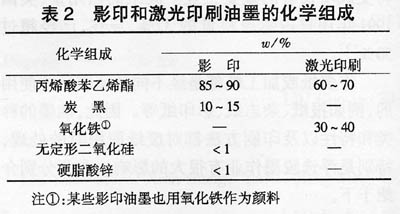1.2.3 Photocopying and laser printing ink
Photolithographic and laser printing inks (ie, toners, or pigments) are dry black powders having densities of 1.21 g/cm<3> and 1.48 g/cm<3> respectively and average particle sizes of about 15 [mu]m and 25 [mu]m, respectively. Similar chemical composition. Styrene acrylate copolymer as its linking agent, the mass fraction of 60% to 90%. The main difference between them is that the laser printing toner contains ω = 35% of iron oxide as the pigment, and the photocopying toner contains ω = 12% of carbon black as the pigment. See Table 2 for details.

Since carbon black and iron oxide do not decompose during pyrolysis, the pyrolysis curves of photolithographic and laser printing inks are very similar. Both have a single decomposition peak between 350 and 460°C. Their decomposition products are considered to be the same by mass spectrometry. Both are dimers and trimers and acrylates of styrene, alpha-methylstyrene, toluene, methyl acrylate, benzene, acrolein, and styrene. After the decomposition of the printing toner, there is about ω=20% residue. The decomposition temperature of the photolithographic and laser printing toner is lower than the decomposition temperature of pure polystyrene and pure polyvinyl ester, which may be due to the presence of pigments and metal additives in the toner.
Although there are many kinds of ink, it has been found that the main product after the ink is decomposed is a non-polar compound such as a hydrocarbon. Therefore, these inks are originally hydrophobic, ie they have a larger contact angle (>80°) for water, see Table 3. The larger the contact angle, the greater the hydrophobicity and the more favorable it is to be floated from the fiber suspension.
These hydrophobic inks are easily separated from hydrophilic cellulose fibers during flotation.
2. Effect of Printing Methods on Ink Properties and Flotation Deinking

The basic requirement for printing ink is to meet the needs of printing methods. For different printing methods, the contact route of the ink and the fiber is different, and the physical and chemical properties of the ink are changed differently. The change of these ink characteristics directly affects the flotation deinking efficiency.
According to the ink solidification mechanism, printing methods can be divided into two categories.
The first type is the printing method where ink is attached by absorption and evaporation. In this case, the ink is adapted to different printing needs with different viscosities.
The lithographic printing method is based on the principle that oil and water cannot be mixed. The image area on the printing plate is made into an acceptable oil-based ink instead of water. The lithographic printing ink is often called an offset oil-based ink and is based on a water-resistant vehicle (connected Agents) and pigments cannot flow out in water or ethanol. The law is used to print newsprint, glossy magazines, books and photographic reproductions. In this method, the offset cold-oil based ink is simply absorbed by the pores of the paper at room temperature, and the pigment is then left on the surface of the paper without further drying. This is the liquid component of the ink that penetrates the paper. Pages, while leaving solid components on paper. Even if the adhesion is carried out under dry or chemical reaction, there is still absorption. Therefore, the properties of offset cold-oil based inks do not change significantly during the printing process.
Letterpress printing and its improved printing, aniline letterpress printing is also this printing method, the ink is used for the convex surface of the printing plate, when the printing plate presses on the paper sheet, the ink on the convex surface of the printing plate is Transfer to paper. The inks for letterpress printing have medium or low viscosity and fast drying properties, commonly used are oil-based and water-based inks. This method is a typical method of printing newspapers and magazines.
Rotary gravure printing is the use of the area of ​​the printing plate recessed to form an image, the ink is filled in the recessed area, and the paper is pressed against the ink by the elastic rubber roller pressed against the recessed area. Rotary gravure printing is typically used to print colored newspapers and magazines.
In letterpress and gravure printing, water-based inks and oil-based offset thermosetting inks are dried by evaporation of volatile solvents (such as water or low-boiling organic solvents such as aromatic hydrocarbons or esters) at 60°C. Other materials are combined with pigments and left on paper. Because no chemical reactions occur during printing, oil-based offset plastisol inks and dried water-based inks retain their original hydrophobic properties after printing.
The second important type of printing method is indirect printing. A relatively high temperature is required during printing to allow the ink to adhere to the fibers. When a finely divided solid ink is used, these printing methods are photocopies and laser printing. (to be continued)